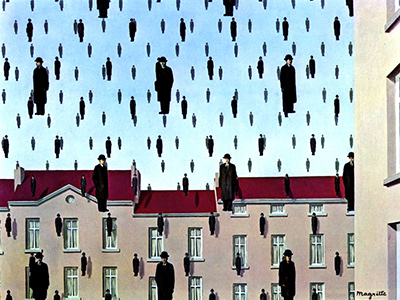 Buy Art Prints Now
Buy Art Prints Nowfrom Amazon
* As an Amazon Associate, and partner with Google Adsense and Ezoic, I earn from qualifying purchases.
Rene Magritte is famous for his use of ordinary images in a way that makes them seem extraordinary.
Surrealism became popular around the turn of the last century and though it took a while to reach the mainstream in terms of interest, it was a very popular movement at the time.
Considering the huge changes going on in the world as the Victorian age ended and a run of long, painful wars began, it is not surprising that artists began looking for the bizarre in life to challenge people's perceptions.
As one of Magritte's most well-loved paintings, 'Golconde' (or, in English, 'Golconda') is a great example of this. It displays an array of identically-dressed white men in black suits with bowler hats raining from the sky in front of a suburban scene.
It is possible that the men are being lifted from the ground like balloons rather than descending from the sky, as there is no real movement displayed within the scene, and nothing to denote either direction.
In fact, each of the men have splayed, flat feet as if they were standing upon a flat surface, adding to the strangeness of the painting. Perhaps in fact the men are stationary in the sky, suspended where they are for whatever reason makes sense.
Magritte himself wore outfits such as these grey suits and bowler hats, as they were very much the norm at the time of the painting. It is possible then that he was commenting not just on the culture that surrounded him but also the way that culture reflected his own identity, and what that meant.
He also lived in a suburban area for some of his life, which is mirrored in the plain houses behind the men.
However we will never truly understand Magritte's paintings even when gathering as much clues from his life as possible, as he eschewed giving away any explanation for his work. This is another layer of maintaining the surrealist nature of his work; to explain it too much would remove the mystery, and when the mystery is a large part of what makes the art so appealing, that becomes troublesome.
When an artists plays with such powerful themes and interesting forms, there is the tendency to forget the masterful use of his medium. Magritte took a simple motif in the man in the bowler hat (a common theme in his work), and turned it into a complex, interesting scene. The suburban houses beyond seem deliberately bland, almost painfully so, and this makes the whole scene seem more ordinary. This use of normalcy against the bizarre makes the latter stand out more. Perhaps Magritte was commenting on how bizarre the bland lifestyle some choose can be.
The name adds a suggestion on the meaning behind the painting. 'Golconde' was a city once in Andra Pradesh in India, now only in ruins. It was once the capital city in two large civilisations, and is now famous for its proximity to mines that have produced some of the most infamous diamonds in the world. Once such diamond is 'Koh-i-Noor', discovered some time around the 13th Century, that is now part of the Crown Jewels in the UK monarchy's possession.
Due to the connotations of wealth that the city held, the name now is listed in the dictionary to mean 'a mine of wealth'. Because of this it is entirely likely that Magritte intended to comment on the wealth of the suburban lifestyle and how bland it has become. Such well-dressed men in uniform houses would be a great source of wealth, though it is possible they would not produce something as beautiful as the Koh-i-Noor diamond.
Of course, Magritte once said that his paintings mean nothing because mystery means nothing. In that case looking so deeply into the meaning behind an image is doomed to be fruitless.
However, even if one does not look into the inherent meaning in the image, it is still possible to enjoy the image immensely. The regular set of the men gives the image depth and a pleasing pattern, and though the colours are muted they still feel rich and interesting next to one another. Each of the men is different in their own way, despite the way they are dressed, and looking between them to study their features almost brings the others alive as you bring movement to the picture.
Magritte was a talented and successful surrealist, and with 'Golconde' it is not difficult to see why. He brings simple motifs into an unusual scene which forces the viewer to look at it with added interest rather than passing over it as one might with the painting of a man in a suit without such a fascinating background. This use of setting to force the mind onto a simple sight is masterful, and there are few examples of it that are so clear and efficient as 'Golconde'.




